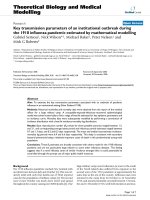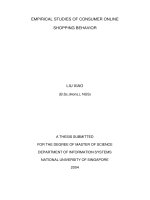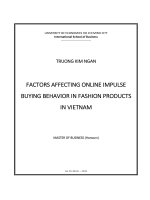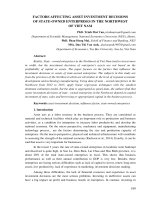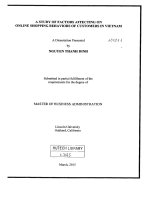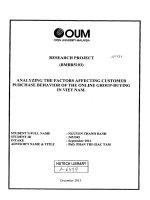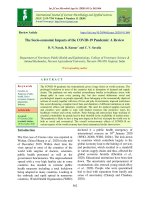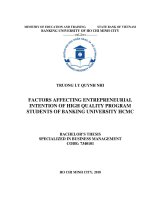Factors affecting online shopping behavior of banking university students during the covid 19 pandemic
Bạn đang xem bản rút gọn của tài liệu. Xem và tải ngay bản đầy đủ của tài liệu tại đây (1.42 MB, 97 trang )
STATE BANK OF VIETNAM
MINISTRY OF EDUCATION AND TRAINING
BANKING UNIVERSITY OF HO CHI MINH CITY
NGUYEN DO NGOC TRAN
(Student code: 030633171432)
FACTORS AFFECTING ONLINE SHOPPING BEHAVIOR OF
BANKING UNIVERSITY STUDENTS DURING THE COVID 19
PANDEMIC
GRADUATE THESIS
MAJOR: BUSINESS ADMINISTRATION
CODE: 52340101
SUPERVISOR
PhD. NGUYEN VAN THICH
HO CHI MINH CITY, 03 – 2021
STATE BANK OF VIETNAM
MINISTRY OF EDUCATION AND TRAINING
BANKING UNIVERSITY OF HO CHI MINH CITY
NGUYEN DO NGOC TRAN
(Student code: 030633171432)
FACTORS AFFECTING ONLINE SHOPPING BEHAVIOR OF
BANKING UNIVERSITY STUDENTS DURING THE COVID 19
PANDEMIC
GRADUATE THESIS
MAJOR: BUSINESS ADMINISTRATION
CODE: 52340101
SUPERVISOR
PhD. NGUYEN VAN THICH
HO CHI MINH CITY, 03 – 2021
1
ABSTRACT
The study discusses the factors affecting the online shopping behavior of banking
university students during Covid 19 based on Ajzen and Fishbein's Theory of Reasoned
Action (1980), Theory of Planned Behavior Theory of Planned Behavior-TPB) by Ajzen
(1991) along with domestic and foreign referenced research articles on online shopping
behavior such as: Ha Ngoc Thang (2016), Nguyen Le Phuong Thanh (2013), Javadi et al
(2012), Neger and Uddin (2020), Alhaimer (2021). The questionnaire was posted to student
groups of Banking University of Ho Chi Minh City. The responses from students obtained
through the questionnaire will be recorded through the researcher's email address. After 1
month of collection, 160 valid responses were included in the analysis. Data is analyzed
according to the process from factor analysis to reliability test and regression analysis. The
results show that, subjective norm has the most important significance for online shopping
behavior (with the largest coefficient), followed by attitude and perceived behavioral
control, respectively.
2
ACKNOWLEDGEMENT
Thesis is study my own research results are honest, while no content has been previously
published or content by others made except citations citation fully in the thesis.
To complete this article, first of all, I would like to express my deepest gratitude to PhD.
Nguyen Van Thich - who wholeheartedly guided and helped me to complete this research.
Because of my limited knowledge, in the process of researching, I inevitably make
mistakes, and I would like to receive suggestions from teachers.
3
TABLE OF CONTENTS
CHAPTER 1: GENERAL OVERVIEW ....................................................................... 10
1.1. Background......................................................................................................... 10
1.2. The urgency of the topic .................................................................................... 11
1.3. Research objectives ............................................................................................ 12
1.4. Research question .............................................................................................. 12
1.5. Research object and Research scope ................................................................ 12
1.6. Research Methods .............................................................................................. 13
1.7. Research content ................................................................................................ 14
1.8. Research contribution ....................................................................................... 14
1.9. Structure of research ......................................................................................... 15
CHAPTER 2: LITERATURE REVIEW ...................................................................... 16
2.1. Basic Concepts .................................................................................................... 16
2.1.1.
Online shopping concept .......................................................................... 16
2.1.2.
Concept of consumer behavior ................................................................. 16
2.1.3.
Consumer decision-making process ......................................................... 17
2.2. General theories and research models of consumer behavior ....................... 19
2.2.1.
Theory of Reasoned Action – TRA........................................................... 19
2.2.2.
Theory of Planned Behavior – TPB ......................................................... 20
2.3. Factors affecting online shopping behavior: ................................................... 21
2.3.1.
Attitude ...................................................................................................... 21
2.3.2.
Price ........................................................................................................... 22
2.3.3.
Subjective norms ....................................................................................... 22
4
2.3.4.
Perceived behavioral control .................................................................... 23
2.3.5.
Perceived risk ............................................................................................ 23
2.4. Overview of research ......................................................................................... 24
2.4.1.
Domestic research ..................................................................................... 24
2.4.2.
Foreign research ....................................................................................... 27
2.4.3.
Proposed research model .......................................................................... 30
CHAPTER 3: METHODOLOGY ................................................................................. 32
3.1. Research design .................................................................................................. 32
3.1.1.
Method of building a scale ....................................................................... 32
3.1.2.
Research scale ........................................................................................... 33
3.2. Choose a sample ................................................................................................. 39
3.2.1.
Overall ....................................................................................................... 39
3.2.2.
Method of sampling .................................................................................. 39
3.2.3.
Sample size ................................................................................................ 40
3.2.4.
Information gathering .............................................................................. 40
3.2.5.
Information gathering process ................................................................. 40
3.3. Statistical data analysis technique .................................................................... 41
3.3.1.
Testing the reliability of a scale ................................................................ 41
3.3.2.
Testing the reliability of the model ........................................................... 41
3.3.3.
Correlation coefficient and regression analysis ...................................... 42
3.4. Conclusion of chapter 3 ..................................................................................... 42
CHAPTER 4: FINDING ................................................................................................. 44
4.1. Data analysis ......................................................................................................... 44
4.1.1.
Unsuitable answer sheets .......................................................................... 44
5
4.1.2.
Data encryption ......................................................................................... 44
4.2. Sample discription ................................................................................................ 45
4.3. Reliability analysis and appropriate scale .......................................................... 54
4.3.1.
Testing of scale reliability by Cronbach's alpha coefficient ................... 55
4.3.2.
Exploratory factor analysis EFA ............................................................. 60
4.3.3.
Testing of models and hypotheses ............................................................ 68
4.4. Summary of research results ............................................................................ 72
CHAPTER 5: CONCLUSION AND RECOMMENDATION .................................... 74
5.1. Conclusion........................................................................................................... 74
5.2. Recommendations and suggestions ..................................................................... 75
5.3. Research limit ....................................................................................................... 76
REFERENCE................................................................................................................... 78
APPENDIX 1.................................................................................................................... 82
APPENDIX 2.................................................................................................................... 89
6
LIST OF ABBREVIATIONS
Abbreviation
Original
HCMC
Ho Chi Minh city
TRA
Theory of reasoned action
TPB
Theory of planned behavior
IT
Information Technology
A
Attitude
P
Price
SN
Subjective norms
PBC
Perceived behavioral control
PR
Perceived risk
OSB
Online shopping behavior
7
TABLE LIST
Table 3. 1 Summary of scale ............................................................................................. 37
Table 4. 1: Statistics for gender.........................................................................................45
Table 4. 2: Statistics for school year ................................................................................. 45
Table 4. 3: Statistics for major .......................................................................................... 46
Table 4. 4: Statistics for income ........................................................................................ 47
Table 4. 5: Statistics for How long have you been using Internet..................................... 48
Table 4. 6: Statistics for How many hours in a day do you use the Internet ..................... 48
Table 4. 7: Statistics for shopping sites do you usually buy during Covid? ..................... 49
Table 4. 8: Statistics for products do you usually buy when shopping online .................. 49
Table 4. 9: Descriptive Statistics for Attitude ................................................................... 50
Table 4. 10: Descriptive Statistics for Price ...................................................................... 51
Table 4. 11: Descriptive Statistics for Subjective norms .................................................. 51
Table 4. 12: Descriptive Statistics for Perceived behavioral control ................................ 52
Table 4. 13: Descriptive Statistics for Perceived risk ....................................................... 53
Table 4. 14: Descriptive Statistics for Online shopping behavior ..................................... 54
Table 4. 15: Reliability Statistics for Attitude ................................................................... 55
Table 4. 16: Reliability Statistics for Price ........................................................................ 55
Table 4. 17: Reliability Statistics for Subjective norms .................................................... 56
Table 4. 18: Reliability Statistics for Perceived behavioral control first time .................. 57
Table 4. 19: Reliability Statistics for Perceived behavioral control second time ............. 58
Table 4. 20: Reliability Statistics for Perceived risk ......................................................... 58
Table 4. 21: Reliability Statistics for Online shopping behavior ...................................... 59
Table 4. 22: KMO coefficient and 1st Bartlett's test ......................................................... 60
Table 4. 23: Eigenvalues and % explaining factors first time ........................................... 60
Table 4. 24: Convergence coefficient of factors forming first time .................................. 61
Table 4. 25: Discriminant value between observed variables first time ........................... 62
Table 4. 26: KMO coefficient and 2nd Bartlett's test ......................................................... 63
Table 4. 27: Eigenvalues and % explaining factors second time ...................................... 63
8
Table 4. 28: Convergence coefficient of factors forming second time ............................. 64
Table 4. 29: Discriminant value between observed variables second time ....................... 65
Table 4. 30: KMO coefficient and Bartlett's test ............................................................... 66
Table 4. 31: Eigenvalues coefficients and % explaining factors ....................................... 66
Table 4. 32: Convergence coefficient of forming factors ................................................. 67
Table 4. 33: Correlation between independent variable and dependent variable .............. 68
Table 4. 34: Model summary table .................................................................................... 69
Table 4. 35: ANOVA test table ......................................................................................... 69
Table 4. 36: Hypothesis testing ......................................................................................... 70
Table 4. 37: Standardized Coefficients ............................................................................. 72
9
MODEL LIST
Model 1: Theory of Reasoned Action - TRA ................................................................... 20
Model 2: Theory of Planned Behavior – TP .................................................................... 21
Model 3: Research model in research of Thang (2016) ................................................... 25
Model 4: Research model in research of Chau & Dao (2012) ......................................... 26
Model 5: Research model in research of Javadi et al. (2012) .......................................... 28
Model 6: Research model in research of Neger and Uddin (2020) .................................. 29
Model 7: Research model ................................................................................................. 31
Model 8: Modified research model .................................................................................. 69
10
CHAPTER 1: GENERAL OVERVIEW
1.1. Background
Nowadays, online shopping become more popular because of the convenience and speed
it offers. Just one click to get what you need without going to the store. Especially since
the occurrence of Covid-19, it has changed the consumer trend and is very reasonable
reason for the booming online shopping environment. Winning will belong to the
business that changes quickly and seizes the fastest opportunity. Over the past few
decades, the Internet has evolved into a vast global marketplace for the exchange of
goods and services. In many developed countries, the Internet has been used as an
important means, providing a wide range of products with 24-hour availability and wide
coverage. According to Chen (2009), research on consumer online shopping behavior is
one of the most important research programs in the past decade. Online shopping (also
known as online shopping and Internet buying / buying) refers to the process of
purchasing a product or service through the Internet. Online shopping has distinct
advantages such as: Consumers can easily access product information from many
different sources: websites, social networks (facebook, instagram, ...). In particular, the
websites providing product price comparison services from other websites have provided
very good support for consumers in making online purchases. The online form provides
a wide variety of products and services, especially clothing, electronics, toys, and
cosmetics. Most e-commerce exchanges allow customers to review a product after
purchasing it. Therefore, consumers can learn about products carefully before deciding
to buy. Especially saving time for consumers, especially students while studying at
school. However, the proportion of Vietnamese consumers, especially students,
participating in online shopping was still lower than in other countries in the region and
around the world during the Covid translation. According to Sylke et al. (2002) in a
number of other countries, e-commerce business-to-consumer is much lower than the
11
expected share of total retail enterprise due to its certain limitations. Therefore, in order
to attract consumers, especially students who shop more online, it is very necessary to
know the factors that affect the shopping behavior of customers. online. That is why I
chose the topic “Factors affecting online shopping behavior of Banking University
students during the Covid 19 pandemic” as the research topic. From the research results,
the author will give detailed explanations about the factors affecting online shopping
behavior of Banking students during the Covid 19 translation, and at the same time find
solutions to help sellers. Online retail is closer to shoppers.
1.2. The urgency of the topic
A recent Nielsen survey released at the Online Marketing Forum 2020 showed that the
number of consumers shopping online increased by 25%, while in traditional channels
such as supermarkets, markets and groceries only increased 7%, 3% and 6%
respectively. Ms. Le Minh Trang, representative of Nielsen Vietnam Company, assessed
that the online shopping trend in Covid-19 has opened up more online business
opportunities when people choose to shop at home increased. Online shopping has a 2digit annual growth rate and this number is likely to grow in Vietnam. Due to the
COVID-19 pandemic, world trade and trade, education and other activities were
disrupted. The global supply chain has been broken because the countries are locked. As
a developing country, Vietnam has suffered parallels by this outbreak. Therefore, this
research is designed to help online retailers have more overview of their customers, from
which more solutions to attract customers through online shopping sites, especially
during Covid translation. This study is also essential to evaluate overall factors affecting
online shopping behavior of students, to help them increase awareness of their own
shopping behavior. Although there are many theories and research models in the world
that explain the factors affecting the behavior of online shoppers, there are not many
specific studies in the country about the factors that affect the behavior of online
shoppers. Factors affecting online shopping behavior of consumers, especially the
12
student segment during Covid translation time 19. Models around the world when
applied to Vietnam will not be appropriate due to the culture, economy, society.
Therefore, based on the models in the world and the studies in the country over the past
time, building a model suitable with the situation of Vietnam is essential.
1.3. Research objectives
-
General objective
Find out the factors that influence students' online shopping behavior during the outbreak
and the impact of each of these factors, and contribute to the research team's opinion on
researchers' solutions, providing online shopping services to attract customers during the
Covid 19 pandemic.
-
Specific objective
- Systematize the theoretical basis of students' online shopping behavior during the
Covid pandemic 19
- Find out the factors affecting online shopping behavior of the students of the
University of Banking in Ho Chi Minh City during Covid 19, at the same time
research the influence level of each of these factors
- Contribute solutions for service providers to purchase online and attract more
customers during the Covid 19 pandemic.
1.4. Research question
- What factors affecting the online shopping behavior of HCM Banking University
students during Covid 19?
- What is the influence of factors affecting online shopping behavior of Ho Chi Minh
City Banking University students during Covid 19?
- What improvements or changes are needed from online shopping service providers
to attract student customers to use?
1.5. Research object and Research scope
-
Research object
13
Study subjects are factors affecting online shopping behaviors of Banking University
students in Ho Chi Minh City during Covid 19. Subjects selected for the survey are
Banking University students. This is a young audience, knowledgeable about online
shopping, so their buying behavior to a certain extent can represent all types of
consumers in society. The study period is from March 2020 to March 2021.
-
Research scope
- Scope of space: Research conducted at Banking University of Ho Chi Minh City
- Scope of time: Secondary data from 2020-2021, primary data taken from survey
samples during February 2021 to March 2021.
1.6. Research Methods
The research team selected the observation sample of this topic as "a student of the
Banking University of Ho Chi Minh City" for the following reasons:
- Firstly, for students, time and cost are two issues that need to be considered when
conducting the investigation, so the topic chooses this subject so that it does not take
much time and costs for sampling research. assist.
- Second, "students of Banking University of Ho Chi Minh City" are those who have
been using online shopping regularly.
Qualitative research: to explore the factors affecting online shopping behavior of
students during Covid time and adjust the scale of the factors in the proposed research
model. Qualitative research results serve as a basis for questionnaires to collect
information to perform quantitative research.
Quantitative research: used to measure the influence of these factors on students' online
shopping behavior during Covid time.
- Evaluate the reliability of the scales by testing Cronbach's Alpha.
- Analysis of discovery factors EFA by KMO test
Regression analysis and testing hypotheses with F and Sig tests.
14
- T-Test and ANOVA test to find out significant differences in online shopping
behavior among student customers.
- Using SPSS.
1.7. Research content
Research on consumer behavior of the student segment of the Banking University of Ho
Chi Minh City with online shopping including cultural, social, personal, psychological,
... and customer purchasing decision-making process. From there, evaluate the online
shopping form during the epidemic, with the shopping demand for this segment, see if
there is any change compared to before the Covid outbreak 19. The study will use the
theory and empirical research by domestic and foreign authors who have done research
on online shopping behavior in general, to have analysis and understanding of this issue
for the student segment. From the results obtained during the research process, the author
will give an explanation of the factors affecting online shopping behavior of Ho Chi
Minh City Banking University students during Covid 19 and give their opinion. The
author's solutions to attract users to shop online during the pandemic.
1.8. Research contribution
-
In theory
Buying online is no longer a new field in Vietnam, but when buying goods during Covid
19 there is a difference. The topic contributes a different perspective and more overview
in the field of online shopping during the pandemic, through building a theoretical model
explaining the factors affecting the online buying behavior of students. The scales in the
proposed research model were implemented in India, Iran, Bangladesh ..., this study
adjusted and tested the scales in the Vietnamese environment through survey data.
experiment at Banking University, should contribute to research and application in the
Vietnamese market. Therefore, in addition to inheriting the previous studies, this
research will provide a clear solution for online retailers to compete most effectively
during Covid 19.
15
-
In practical
After the study is successful, the topic will help the reference to identify the factors
affecting online shopping behavior during the time of Covid 19 of the current student of
Ho Chi Minh City University of Banking and the degree of influence. of the above
factors. The topic will not target general customers but will focus on students of HCMC
Bank. From there, researchers can expand research further or use information for related
studies.
1.9. Structure of research
Chapter 1: General overview
Introducing an overview of the topic, this chapter includes main contents such as
research reasons, research questions and objectives, research scope and object, and
research methods.
Chapter 2: Literature review
Chapter 3: Methodology
This chapter includes the main contents such as detailing research methods, describing
research samples, making hypotheses and proposing research models.
Chapter 4: Finding
Chapter 5: Conclusion and recommendation
16
CHAPTER 2: LITERATURE REVIEW
2.1. Basic Concepts
2.1.1. Online shopping concept
Online shopping is a form of commerce and electronics that allows customers to buy
products or services directly from sellers over the internet. Online shopping is one of the
forms of e-commerce, becoming increasingly important in developing B2C e-commerce
since the late twentieth century. Online shopping is defined as a service where consumers
use electronic devices with an Internet connection to make purchases (Turban et al.,
2006). Online shopping encompasses a wide range of social changes, markets that are
characterized by globalization, and the shift of the current economy based on knowledge,
information, and technology in life. Every day, some businesses have taken advantage
of online sales instead of traditional sales, which will help them reduce transaction costs,
search, develop a broader market, and reduce the gap between buyers and sellers.
Monsuwe, Dallaert, and Ruyter (2004) have compared both offline and online and found
that shopping online is more accessible than shopping offline, which takes less time and
effort. In addition, consumers can access more information related to products and
services, helping them compare prices and product quality with other manufacturers. In
general, customers can easily receive any data and information from the internet (Wang,
Ye, Zhang & Nguyen, 2005). When shopping online, consumers cannot touch and feel
a product before buying, but online services provide more information about their
products and services so that the customer can rate the products and services when they
need it (Lim & Dubinsky, 2004).
2.1.2. Concept of consumer behavior
Consumer behavior refers to consumers' behavior in purchasing, using, evaluating, and
rejecting products and services that consumers expect will satisfy their needs.. Consumer
behavior focuses on whether with existing resources (time, money, effort), the individual
will decide how to use them on the consumption of relevant items. It includes what they
17
buy, why, when to buy, where, how often they buy them, how often they use them, how
they are assessed after purchase, how these ratings affect those next purchase, and how
they dispose of them.
Consumer behavior involves both aspects: the mental decisions (thoughts) and the
physical actions of the body created from those decisions/thoughts.. Consumers are those
who buy and/or use products or services provided in the market. Consumers are generally
divided into two basic groups: personal consumers and organizational consumers.
Personal consumers are those who buy goods or services for their purposes (e.g., brushes,
combs ...), for families (e.g., television, table ...), for relatives (lipstick , clothes…),
friends (gift). These consumers are also referred to as end-users/ultimate consumers.
Institutional consumers include business organizations (enterprises), administrative and
non-business units, ... They are the buyers of products and services for the operation of
agencies and organizations. In consumer behavior research, the focus is usually on
individual consumers since end consumption is the factor that covers all the different
types of consumer behavior and is relevant to all person as a buyer, consumer, or both.
2.1.3. Consumer decision-making process
Researchers have found that consumers seem motivated and influenced by family,
friends, and advertising when buying products/services and are affected by mood,
circumstances, and feelings. These factors combine to form a general, comprehensive
model of consumer behavior, which both reflects the cognitive side and the emotional
side of the consumer decision-making process.
The consumer decision-making process consists of three phases: the input phase, the
processing stage, and the output stage. The input stage influences consumers' perceptions
of product needs, including two primary sources of information: the company's
marketing efforts (products, pricing, promotions, and distribution channels) and factors.
External social factors impact consumers (family, friends, neighbors, culture, and
subculture). The processing phase focuses on consumer decisions like. How the
18
individual psychological factors (motivation, perception, education, personality,
opinion) affect the output factors influenceaffect consumers' perception of need.
information, seek information before purchasing and reevaluate how the selection
process is. Experience gained through evaluating choices will, in turn, affect the inherent
psychological attributes of consumers. The output stage consists of two activities that
are closely related: purchasing behavior and post-purchase evaluation. Buying behavior
for low-cost, non-permanent products can be influenced by manufacturer promotions
and possibly a trial purchase if the consumer feels satisfied, maybe they will come back
to buy again continued. The trial is the stage of surveying how consumers are judging
by using a product directly. The act of returning to buy a customer's product proves that
the consumer has accepted it. For products that are relatively durable such as laptops
(which are relatively durable due to quickly becoming out of date) signal acceptance.
Researchers have found that when buying products/services, consumers seem motivated
and not only influenced by family, friends, advertising, but also influenced by mood,
circumstances, feelings. All of these factors combine to form a general, comprehensive
model of consumer behavior, which both reflects the cognitive side and the emotional
side of the consumer decision-making process.
The consumer decision-making process consists of three phases: the input phase, the
processing stage, and the output stage. The input stage influences consumers' perceptions
of product needs, including two main sources of information: the company's marketing
efforts (products, pricing, promotions and distribution channels) and factors. external
social factors impact on consumers (family, friends, neighbors, culture and subculture).
The processing phase focuses on consumer decisions like. How the individual
psychological factors (motivation, perception, education, personality, opinion) affect the
output factors affect consumers' perception of need. information, seek information
before purchasing, and reevaluate how the selection process is. Experience gained
through evaluating choices will in turn affect the inherent psychological attributes of
19
consumers. The output stage consists of two activities that are closely related: purchasing
behavior and post-purchase evaluation. Buying behavior for low-cost, non-permanent
products can be influenced by manufacturer promotions and possibly a trial purchase if
the consumer feels satisfied, maybe they will come back to buy again. The trial is the
stage of surveying how consumers are judging by using a product directly. The act of
returning to buy a customer's product proves that the consumer has accepted it. For
products that are relatively durable such as laptops (which are relatively durable due to
quickly becoming out of date) signal acceptance.
2.2. General theories and research models of consumer behavior
2.2.1. Theory of Reasoned Action – TRA
The theory of reasoned action (TRA), developed by Fishbein and Ajzen, is one of the
most influential theories used to explain human behavior. According to this theory,
behavioral intent can be explained by attitudes towards behavior and subjective norms,
designed to explain behavior in general. Attitudes towards behavior are defined as an
individual's "positive or negative feelings (performance evaluation)" about the
performance of the target behavior "(Fishbein and Ajzen, 1975).
Studies over the decades show that attitudes do not predict much of behavior. Vicker
(1969) concludes, "in general, attitudes do not appear to be related or weakly related to
behavior". From the results of these studies, Fishbein and Ajzen (1980) discovered the
method of predicting behavior from their reasoned action theory (TRA) attitudes and
concluded that it is not attitude but rather planned behavior is a predictor of behavior.
Behavioral Intention (I) is the most crucial factor determining a person's behavior. This
intent is defined by Attitude (A) for the performance of the behavior and the Subjective
Norms (SN) related to the behavior. The Intent is seen as the closest and most important
predictor of behavior, and it is influenced by attitudes and subjective norms.
20
Model 1: Theory of Reasoned Action - TRA
(Source: Fishbein & Ajzen, 1975)
2.2.2. Theory of Planned Behavior – TPB
Theory of Planned Behavior (TPB) of Ajzen 1991 is the development and improvement
from the rational action theory model (Fishein & Ajzen, 1975). According to planned
behavioral theory, attitudes, subjective norms, and perceptions of behavioral control
influence a consumer's intent to act. Compared with TRA, the TPB model adds a
cognitive factor that controls behavior affecting behavioral intention. In addition, the
element of belief about facilitation involves the perception factor of behavioral control.
According to Bunchan (2005), behavioral theory with TPB was born to overcome this
weakness.
According to TPB, "behavioral intent" of customers is affected by "attitudes",
"subjective norms" and "perception of behavioral control". TPB has been widely
accepted and used in studies to predict specific user intent and behavior of individuals.
The empirical studies have shown the suitability of this model in studying consumer
behavior in the context of online shopping. Hansen et al. (2004) tested both TRA and
TPB models, and the results showed that the TPB model explains customer behavior
better than the TRA model. Moreover, given the relevance of the research context in
21
Vietnam, several studies have shown that TPB is more suitable for predicting consumer
online shopping intentions.
Model 2: Theory of Planned Behavior – TP
(Source: Ajzen, 1991)
2.3. Factors affecting online shopping behavior:
2.3.1. Attitude
Attitude is an emotional appreciation, a tendency to act in a good or bad way about an
object or idea. Attitude puts people in the thought of liking or disliking, feeling familiar
with, or alienating a particular thing or idea. When buyers have a positive or positive
attitude, they turn to the brand they are looking for. In today's competitive environment,
determining the buyer's attitude towards the product is very important because it is the
factor that strongly influences their behavior. Since then, companies have set up
marketing strategies to adapt to the market situation, affect and change customers'
attitudes in the most profitable direction.
Online shopping will directly affect users' attitudes towards online shopping, and their
attitudes will have a significant impact on online buying behavior. Online buyer attitudes
22
significantly and positively influence their online buying behavior (Ariff et al., 2014).
The consumer's attitude towards engaging in behavior has been shown to be a strong
predictor of behavior (Fishbein & Ajzen 1975). Attitude refers to online consumer
acceptance as a shopping channel (Olson et al., 2001). Previous studies have shown that
online shopping attitudes are an important predictor of online purchases (Yang et al.,
2007).
2.3.2. Price
Price is an essential factor affecting buying behavior of customers. Prices can be
expressed in amounts charged for products or services or the amount that consumers pay
to receive, buy or use products or services (Kotler & Armstrong, 2012). Satit, Tat, Rasli,
Chin and Sukati (2012) argue that, between product, price, location and promotion, price
is the only factor that influences consumers more in purchasing decision in most cases.
To attract consumers, companies often offer competitive prices, launching multiple
promotions for their products. According to Andreti, Zhafira, Akmal, and Kumar (2013),
most consumers go to convenience stores to buy goods because the price is reasonable
and has a significant impact on customers. Munusamy and Hoo (2008) find that the
pricing strategy significantly influences the customer's motivation and the consumer's
buying decision.. Consumers care about the price and consider the price when deciding
to buy a product.
2.3.3. Subjective norms
Ajzen (1991) defines subjective norms as the perception of influencers who should or
should not perform the behavior. According to the theory of reasoned action - TRA
(Azjen & Fishbein 1980), human behavior is formed from intention, based on consumer
attitudes towards behavior and perception. Consumer behavior is influenced by those
around them, such as family, friends, co-workers, the media, and the influencers of
buying behavior. If they say good / bad about the product, it will affect the buying
behavior of consumers. Subjective standards can be described as the individual's
23
perception of social pressures for performing or not performing a behavior. Previous
studies have suggested that there is a positive relationship between subjective norms and
intentions. In the context of online shopping, Lin (2007) argued that subjective
benchmarks reflect consumer perception of the group's influence on the ability to shop
online.
2.3.4. Perceived behavioral control
Perceived behavioral control is defined as an individual's perception of how easy or
difficult it is to perform a certain behavior. It denotes the degree of control over the
behavior's performance, not the results of the behavior. In the context of online shopping,
behavioral control perceptions describe consumer perceptions of the availability of
necessary resources, opportunities to make online shopping. Perceived behavioral
control has been shown to have a positive impact on consumers' online shopping
intentions. Perceptions of behavioral control reflect the perception of internal limitations
(self-efficacy) as well as external limitations in behavior such as resources available.
Perceptions of behavioral control directly influence online shopping behavior (George
2004) and have a strong relationship with online shopping (Khalifa & Limayem 2003).
2.3.5. Perceived risk
According to Bauer (1960), risk-aware consumer behavior of IT products includes two
factors: perception of risk related to products/services and perception of risk related to
online transactions. online. The product/service-related risk perception component
includes risk perceptions such as loss of functionality, financial loss, time consuming,
and total risk perception with the product/service. According to Pavlou (2003), the risks
in online shopping include economic risk, seller risk, privacy risk, and security risk. Four
criteria measure perception of risk: not receiving the product, difficulty to test actual
products, unable to come into contact with the product, not pushing the product before
purchasing Forsythe et al., 2006. Meanwhile, Corbitt et al. (2003) argued that two criteria
measure consumer risk perception in online shopping: financial risk and product risk -
